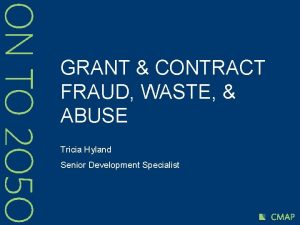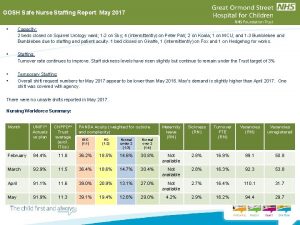Elective Care Data Quality and GOSH Peter Hyland













- Slides: 13

Elective Care Data Quality and GOSH Peter Hyland Director of Operational Performance and Information 4 th May 2017

History • Initial IST review completed in May 2015 and a specific Information review completed in July 2015 • Quality of our data, to ensure patients are treated within 18 weeks, needed to be strengthened • Trust launched the Access Improvement Programme • Programme sought to ensure we see patients within the correct timeframes, with robust plans to see all patients on time in future • Reporting on 18 week referral to treatment waiting times was paused while the bulk of this work was carried out (August 2015 to January 2017)

What we did • Cleaned up our data so that we know who is waiting and for how long • Rewrote our technical processing related to the management elective care (twice) • Changed our operational processes to support better access for patients • Rewrote our Access Policy to make it more robust • Developed in excess of 60 standard operating procedures to support Trust processes • Developed and rolled out an RTT (and Cancer) training model to support delivery of elective care • Undertook a demand capacity exercise across all areas to quantify our capacity issues and inform recovery trajectories • Treated longest waiting patients – waiting lists have come down significantly across the Trust

Reporting and DQ • Returned to reporting in January 2017 – – Jan- 91. 2%, Feb- 91. 6%, Mar- 91. 8% Performance significantly above our agreed recovery trajectory Plan to deliver the 92% standard in 2017 Still have long waiting patients in defined areas • Robust reporting solution developed, tested and implemented- Signed off by IST as ‘best practice’ • Absolute transparency of all elective care patient pathways (not just RTT) – – – Incomplete PTL Planned PTL Outpatient follow up PTL RTT and non-RTT pathways- All managed in the same way Booking reports Automated Unify submission template directly from system

Reporting and DQ (Con’t)

Data Assurance Team Data Assurance and not Data Validation • Movement from a temporary Data Validation team to a substantive Data Assurance Team • 17 WTE including a Data Assurance Manager, 3 x Data Assurance Team Leaders and 13 x Data Assurance Officers • Trust lead and subject matter experts for Data Quality • “Data right first time or corrected at source” • Focus of the team is around all data quality issues and not just RTT • Data Quality dashboard allows individual users to be identified…. almost! • Focus of the team is to: 1. 2. 3. 4. 5. 6. • Identify errors or areas of poor practice and address them Complete audits of data to assure the position Undertake mentoring / training for staff were issues are identified To provide a formal programme of training for staff around RTT, Cancer and Data Quality Support the development of standard operation procedures to define operational processes To undertake (minimal) data validation where required Resource to support our EPR Programme going forward

Data Quality Dashboard • Data Quality dashboard developed to address the needs of the Trust • Options appraisal completed- decision to use an external provider with knowledge transfer to the IS Team • Go-live at the end of March 2017 • 94 individual indicators focusing on DQ, more to follow • 38 dedicated to RTT • Each indicator is assigned a ‘Action Role’ (Data Assurance Team Central / Divisional, Divisional Managers, Performance Team • Daily work lists available based on priority • Direct link to the Trust SOP or other documentation • Governance is through the weekly PTL meetings and Data Quality Review Group

Data Quality Dashboard (Con’t) The application is split into 7 tabs: • Homepage – Allows easy entry into the routine daily reports. • AC DQ Summary – Provides a summary of all available DQ metrics that need to be acted on and can be filtered in a variety of ways. • DQ Measures – Details and references to the SOPs and resolution for each actionable DQ metric. • Records – Patient level detail of all the selected metrics. • Non AC DQ Summary - Provides a summary of all available DQ metrics that do not need specific patient correction but informs on areas that need improvement or review. These can be filtered in a variety of ways. • DQ User Summary – A summary of last modified and created user showing activity areas and metrics. Can track over time and can be used to identify areas that may need training and support. (Limitations in PIMs of the last modified user need to be taken into consideration) • DQ Performance Summary – Overview of metrics and activity areas of numbers of errors and correction details.

Data Quality Dashboard (Con’t)

Data Quality Dashboard (Con’t)

Unknown Clock Starts • Unknown clock starts has been a significant issue for GOSH • 85% of referrals from secondary care • Unknown clock start position in April 2016 - 78%, reduced to 10. 8% in February 2017 • Contacting Trusts and establishing contacts • Support by NHS Improvement- London with discussions and agreed a workable solution – Review of all referrals upon receipt to establish required data – Chase referring Trusts three times for information – Thereafter report as an unknown clock stop • A national solution to this issue is required

So what now…. . • Data Assurance Team and the Data Quality Dashboard is still very new, needs to be embedded • Ensure there is operational ownership of the data and support to rectify issues • Prioritise the tasks required through the Data Quality Dashboard to focus on high impact areas • Review the Trust training package and ensure it meets the needs of the Trust • Issues still arise based on previous practice

Thank you for your time Any questions
 Tricia hyland
Tricia hyland Philip hyland
Philip hyland Gosh conference
Gosh conference Squirrel ward gosh
Squirrel ward gosh Academic writing and composition
Academic writing and composition Aberdeen electives
Aberdeen electives Halimbawa ng bahagi ng sanaysay
Halimbawa ng bahagi ng sanaysay Streamü
Streamü College preparatory elective examples
College preparatory elective examples Elective ict
Elective ict Intoxication énolique
Intoxication énolique Levels of health care primary secondary tertiary
Levels of health care primary secondary tertiary Data cleaning problems and current approaches
Data cleaning problems and current approaches Data quality and data cleaning an overview
Data quality and data cleaning an overview























